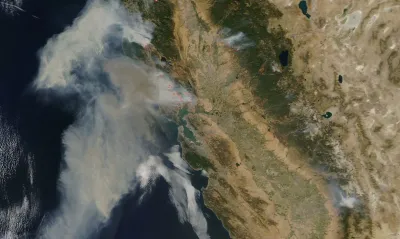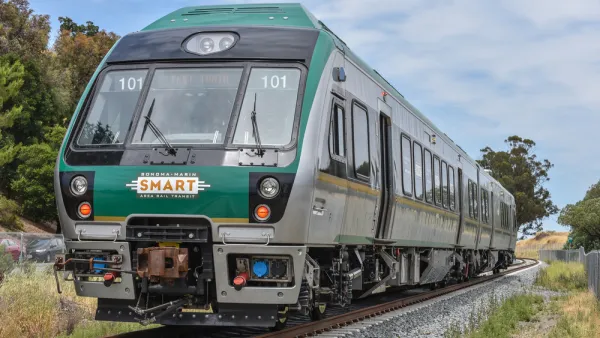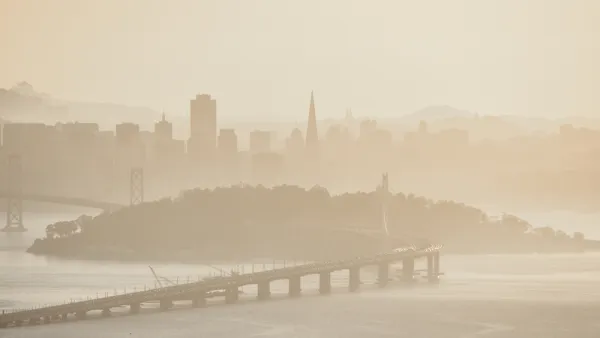The fires in Northern California have caused at least 21 deaths, with over 500 people missing in Sonoma County. Wired science editor, Adam Rogers, looks at the problems posed when urban development encroaches wildlands.

Take a video train ride through what once were Santa Rosa neighborhoods on Sonoma–Marin Area Rail Transit (SMART), courtesy of the San Francisco Chronicle, Oct. 10.
"According to CAL FIRE spokeswoman Heather Williams, 11 people have died in Sonoma County, six in Mendocino County, two in Yuba County and two in Napa County," report Phil Willon, Paige St. John, Louis Sahagun, Sonali Kohli and Chris Megerian for the Los Angeles Times on Wednesday.
"We've had big fires in the past," Gov. Jerry Brown said. "This is one of the biggest."
Cal Fire estimates that around 3,500 structures have been destroyed.
As of noon, Wednesday, over 500 people were reported missing in Sonoma County, according to the San Francisco Chronicle.
Strong winds spread the fires rapidly – which Adam Rogers, science editor for Wired, mentions in his Oct. 11 piece that looks at the wildland-urban interface (WUI).
Blame the wind, if you want. In Southern California they call it the Santa Ana; in the north, the Diablos.
No one yet knows the cause of the more than a dozen fires ablaze around California, but fires start where humans meet the wild forests, where people build for solitude or space or beauty. Things go wrong in those liminal spaces, at the interface between the wilds and the built.
The location of the WUI presents special challenges for firefighters from both sides of the interface.
“Most wildland firefighters are not trained in structural protection, but the urban fire departments are not trained to deal with dozens or hundreds of houses burning at the same time,” says Volker Radeloff, a forestry researcher at the University of Wisconsin. “When these areas with lots of houses burn, the fires become very unpredictable.”
Housing crisis exacerbates fire potential
California housing policies are more likely to push single-family houses out into the edges of communities than encourage the construction of dense city centers.
So keep thinking about blame as northern California rebuilds—if regulations get brave enough to insist on denser cities, less flammable materials, different ornamental vegetation, underground power lines.
For more focus on the WUI nexus with California's housing shortage, see August post by contributing editor Philip Rojc based on an earlier Wired article by Rogers, and September 2016 post from The Wall Street Journal.
Air Quality
The smoke from the North Bay fires have worsened air quality in San Francisco and the Peninsula, reports Amy Graff for The Chronicle.
"We're seeing the worst air quality ever recorded in many parts of the Bay Area," says Tom Flannigan, the [public information officer] for the Bay Area Air Quality Management District. "The entire Bay Area population is likely being affected by the smoke."
The wet winter and climate change may also help explain the intensity of recent fires.
More reading on wildland-urban interface:
- See August 2016 post to read how "Strategic Land Use Planning Could Lower the Cost of Wildfires."
- U.S. Forest Service publication (2013): "Wildfire, Wildlands, and People: Understanding and Preparing for Wildfire in the Wildland-Urban Interface." [pdf]:
This report by the Forests on the Edge project, sponsored by the U.S. Department of Agriculture, Forest Service is intended to heighten awareness of the ecological role and societal costs of wildfire, the causes and impacts of wildfire on human communities, and the relationship between increases in housing development and wildfire risk.
FULL STORY: The Napa Fire Is A Perfectly Normal Apocalypse

Analysis: Cybertruck Fatality Rate Far Exceeds That of Ford Pinto
The Tesla Cybertruck was recalled seven times last year.

National Parks Layoffs Will Cause Communities to Lose Billions
Thousands of essential park workers were laid off this week, just before the busy spring break season.

Retro-silient?: America’s First “Eco-burb,” The Woodlands Turns 50
A master-planned community north of Houston offers lessons on green infrastructure and resilient design, but falls short of its founder’s lofty affordability and walkability goals.

Test News Post 1
This is a summary

Analysis: Cybertruck Fatality Rate Far Exceeds That of Ford Pinto
The Tesla Cybertruck was recalled seven times last year.

Test News Headline 46
Test for the image on the front page.
Urban Design for Planners 1: Software Tools
This six-course series explores essential urban design concepts using open source software and equips planners with the tools they need to participate fully in the urban design process.
Planning for Universal Design
Learn the tools for implementing Universal Design in planning regulations.
EMC Planning Group, Inc.
Planetizen
Planetizen
Mpact (formerly Rail~Volution)
Great Falls Development Authority, Inc.
HUDs Office of Policy Development and Research
NYU Wagner Graduate School of Public Service




























